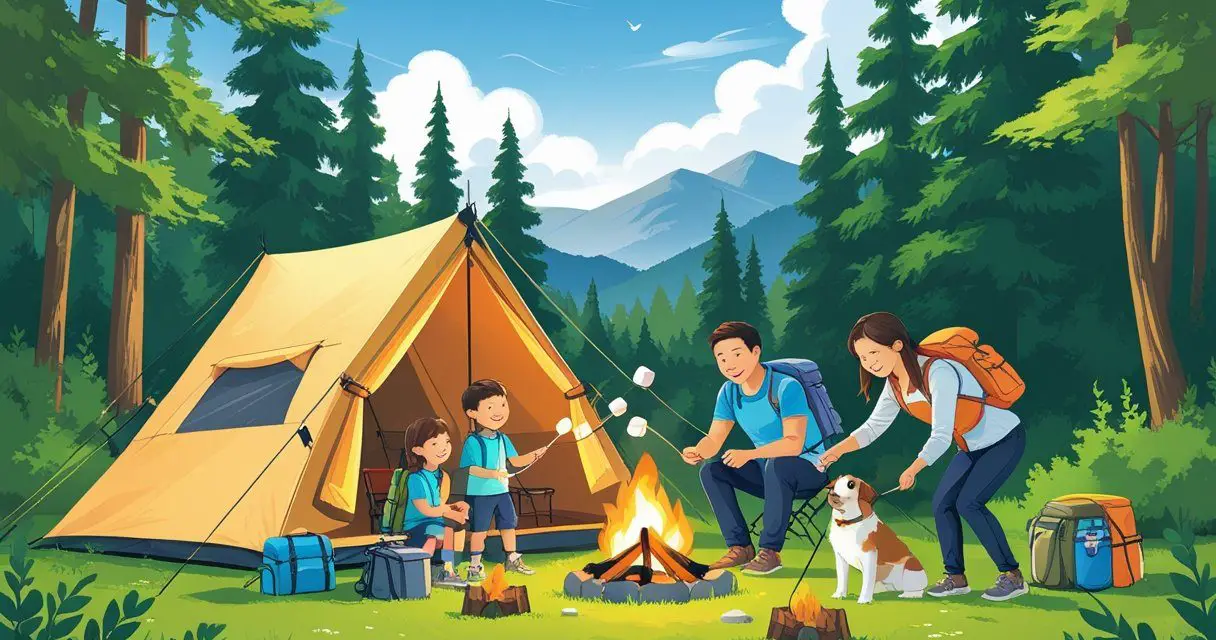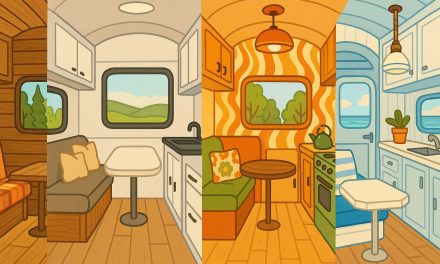Would you like to save this article?
You’ve probably noticed something strange happening at campgrounds across America. There’s an unspoken social hierarchy that exists between campers, and it’s got nothing to do with who builds the best campfire or tells the funniest stories. It’s about what you’re camping in—and everyone’s silently judging everyone else while pretending they’re just there to enjoy nature. From basic tent campers battling mosquitoes to luxury Class A motorhome owners sipping wine from actual glassware, the campground is basically the Hunger Games with propane tanks and folding chairs.
According to the RV Industry Association, there are over 11.2 million RV-owning households in the United States as of 2024, and each type of camper brings their own unique flavor of chaos to the campground. Whether you’re roughing it in a soggy tent or cruising in a six-figure motorhome, you’ve got a place in this wonderfully weird pecking order. The truth is, we’re all suffering in our own special ways—some of us just have air conditioning while we do it.
So grab your s’mores ingredients and your sense of humor, because we’re breaking down the six types of campers you’ll find at every campground. By the end of this article, you’ll know exactly where you fit in the campground food chain—and why that tent camper keeps giving you the side-eye.
1. Tent Campers: The Indie Rockers of the Campground
Let’s start at the bottom of the totem pole (or so the RV owners think): tent campers. These brave souls show up with minimal gear, camping chairs that fold mid-sit, and sleeping bags that inevitably wake up soggier than a wet burrito. They’re the people who risk third-degree burns just to cook a hot dog over a tiny fire pit. Setting up a tent is basically a CrossFit routine—poles break, stakes refuse to stay in the ground, and somehow they convince themselves this is “fun.”
Tent campers are the purists of the camping world. They believe suffering builds character and that mosquitoes treating them like a piñata is just part of the authentic outdoor experience. According to the 2024 North American Camping Report, approximately 23% of campers use tents as their primary camping method, making them a significant portion of the camping community.
Here’s the Reality Check:
You’re out there pretending to love nature while secretly wondering why you didn’t just book a hotel. Your tent decided to leak at 2 AM, your air mattress deflated, and that “waterproof” sleeping bag is now a soggy nightmare. But hey, at least you can tell everyone at work that you’re “getting back to basics.” Meanwhile, the Class A motorhome next to you is running their generator and watching Netflix. You’re not fooling anyone—you’re just broke or stubborn, possibly both.
2. Pop-Up Campers: The Interns of Campground Society
Next up on the ladder are pop-up campers, also known as “tent trailers” or “folding campers.” These contraptions are slightly more structured than tents, featuring canvas sides and sometimes slide-outs that have a nasty habit of sticking at the worst possible moment. Pop-up campers always look down on tent campers, but secretly, they’re hoping a Class A parks next door to block some of the wind.
Setup takes forever—you’ll spend half an hour cranking it up and another hour trying to get the canvas unwrinkled. According to industry data, pop-up campers typically range from $8,000 to $25,000, making them an affordable entry point into RV camping. Their rigs pretend to be luxury, but those $12 folding chairs from Walmart are a dead giveaway.
The Uncomfortable Truth:
You thought you were upgrading from tent camping, but really you’re just camping with extra steps and more things that can break. Every flap of canvas in the wind is a reminder that you’re still basically sleeping outside, just with a thin layer of fabric between you and the bears. You’re the middle child of the campground—not roughing it enough to earn respect from tent campers, not comfortable enough to impress the RV crowd. Every time that canvas flaps at 10 mph, you question why you didn’t just save up for a real trailer.
3. Travel Trailers: The Accountants of the Campground
Welcome to the travel trailer category—the workhorses of the RV world. These rigs are perfect for families, retirees, and weekend warriors who take camping seriously (maybe too seriously). Travel trailer owners will spend half the day setting up: leveling the rig, connecting electric and water hookups, arranging chairs, and positioning coolers with military precision.
According to Statista, travel trailers account for approximately 60% of all RV shipments in North America, making them the most popular type of RV. They range from small teardrops to massive units with multiple slide-outs. Every table, cooler, and camping chair is strategically placed, and if one thing is out of alignment, their entire weekend is ruined.
| Travel Trailer Category | Typical Length | Price Range |
|---|---|---|
| Small/Lightweight | 12-20 feet | $10,000-$25,000 |
| Mid-size | 20-28 feet | $25,000-$45,000 |
| Large/Family | 28-35+ feet | $45,000-$80,000+ |
Your Overachieving Problem:
You’ve turned camping into a science project. You’ve got spreadsheets for your gear, color-coded bins, and you probably label your extension cords. Your kids complain about mosquitoes and uneven ground like it’s a violation of their constitutional rights, while tent campers nearby are telling everyone you’re “not really camping” if you’re using a trailer. Meanwhile, you’re obsessing over whether your rig has enough slide-outs and secretly wondering if you should’ve just bought a fifth wheel.
4. Fifth Wheel Campers: The Royalty Who Think They Own Everything
Now we’re getting into the big leagues. Fifth wheel campers roll in with full living rooms, kitchens with residential appliances, multiple bedrooms, and bathrooms nicer than your house. They pull in with military precision, deploy slide-outs like they’re landing a spacecraft, and have leveling blocks already in place before you’ve even finished your coffee.
Fifth wheels represent about 15% of the RV market and typically range from $40,000 to well over $150,000 for luxury models. These are typically owned by serious full-timers or retirees who genuinely believe they own the entire campground. Their dogs have their own recliners, and their kids have designated spots around the fire pit. Everything is organized, planned, and perfect.
The Power Trip Reality:
You silently look down on everyone at the campground. You judge their firewood, their water hookups, their folding chairs, and probably their life choices. Tent campers fear eye contact with you. Pop-up owners are intimidated. Travel trailer people panic when you pull up next to them. You’re calculating depreciation while other people are roasting marshmallows. Your dog probably has a wine glass, and you treat every minor inconvenience—like wrong leveling blocks or a stuck slide-out—as a full-on emergency. You’re the king of the campground, but nobody actually likes you.
5. Class C Motorhomes: The Smug Middle Children
Class C motorhomes are the mid-size rigs with the distinctive cabover design (that’s the part hanging over the cab where many people put a bed). These RVs are more maneuverable than Class A motorhomes but still bigger than most trailers. Owners think they’re incredibly smart because they can park in spots that Class As can’t fit, and they don’t need a tow vehicle like fifth wheel owners.
Class C motorhomes typically range from $70,000 to $200,000+ and account for roughly 15-20% of the motorhome market. Owners look at themselves as having the perfect balance: technologically advanced, comfortable, and still more practical than a massive Class A.
Your Delusional Confidence:
You’re like that smug high schooler who thinks they’ve outsmarted everyone but really just avoided making a real decision. You know tent campers can’t park in a straight line, and you watch Class A owners do a three-point turn like it’s an Olympic sport. You’re expecting the entire campground to start clapping for your “practical” choice, but really everyone’s just going inside their rigs and silently judging you. You’re not quite luxury, not quite budget—you’re just… there. Congrats on being aggressively mediocre.
6. Class A Motorhomes: The Luxury Overlords
At the top of the food chain sit the Class A motorhome owners—the undisputed royalty of the campground. These luxury rigs feature full kitchens with residential appliances, multiple slide-outs that double the living space, and amenities that would make five-star hotels jealous. They drive slowly through the campground like royalty inspecting peasants. Their dogs wear sweaters, they have fancy welcome mats, and flags marking their domain.
Class A motorhomes range from $100,000 to over $600,000 for luxury diesel pushers, and they represent the pinnacle of RV living. According to the RV Industry Association, Class A motorhomes make up about 15% of the motorhome market but represent a significant portion of the industry’s revenue due to their high price points.
The Humbling Truth:
You don’t camp—you occupy. You conquer nature with cup holders, air conditioning, wine glasses, and probably a washer-dryer combo. If you drop a cork, it’s a national tragedy. While pop-up campers are battling mosquitoes, you’re debating which Netflix show to binge. But here’s the thing: nature humbles everyone. Your fancy motorhome doesn’t make you immune to spilled wine, runaway generators, bathroom pump failures, or that embarrassing moment when you drive away with the power cord still attached. You spent six figures to pretend you’re not really camping, and deep down, you know it’s true.
The Great Equalizer: We’re All Suffering Together
Around the campfire, classes briefly mix. Tent campers whisper survival stories about the rain that flooded their tent. Fifth wheel owners compare slide-outs and talk about mechanical failures. Class A motorhome owners discuss depreciation and fuel costs. And no matter what you’re camping in, pets and kids add to the chaos—your dog steals camping chairs, kids complain about boredom, and everyone’s dealing with raccoons raiding coolers.
At the end of the day, it’s all campground chaos: bathroom lines that are too long, spilled drinks, wildlife encounters, and maybe somebody accidentally parked on your site. When these moments happen, the hierarchy collapses and everybody suffers equally. According to the 2024 Kampgrounds of America (KOA) North American Camping Report, 86% of campers say that camping brings them closer to nature and family, regardless of their camping style.
Campgrounds are the only place where millionaires and broke college students share the same trauma and call it a “weekend getaway.” Nature doesn’t care about your RV’s price tag—mosquitoes, rain, and malfunctioning equipment are equal opportunity tormentors.
Final Thoughts
So, which camper are you? Are you the tent camper pretending to love roughing it? The pop-up owner stuck in the awkward middle? The organized travel trailer family? The fifth wheel royalty? The smug Class C driver? Or the luxury Class A owner pretending you’re not just glamping?
Here’s the beautiful truth: it doesn’t actually matter. Sure, we all judge each other from behind our camping chairs and RV windows, but at the end of the day, we’re all out there trying to enjoy nature (or at least convince ourselves we’re enjoying it). The campground social hierarchy might exist, but it’s really just comedy—a way for us to laugh at ourselves and each other.
Next time you see a Class A gliding past your site, don’t hate. Just wave, smile, and maybe throw them a granola bar. After all, that’s all the social mobility your campsite’s going to allow. Whether you’re sleeping on the ground or in a king-size bed with a memory foam mattress, you’re part of the camping community—and that’s something worth celebrating.
Now get out there and embrace your place in the campground food chain. And remember: the best camper is the one you’re actually using, not the one sitting in storage because you’re too intimidated to take it out.
SOURCES
- RV Industry Association – RV Ownership Statistics: https://www.rvia.org/
- 2024 North American Camping Report – Camping Demographics: https://www.kampgrounds.com/
- Statista – RV Shipment Data and Market Analysis: https://www.statista.com/
- Kampgrounds of America (KOA) – 2024 North American Camping Report: https://www.koa.com/
- The Camping Loop YouTube Channel – “Campground Social Hierarchy: The Truth Exposed”: https://www.youtube.com/watch?v=hstj1PmCp9o





